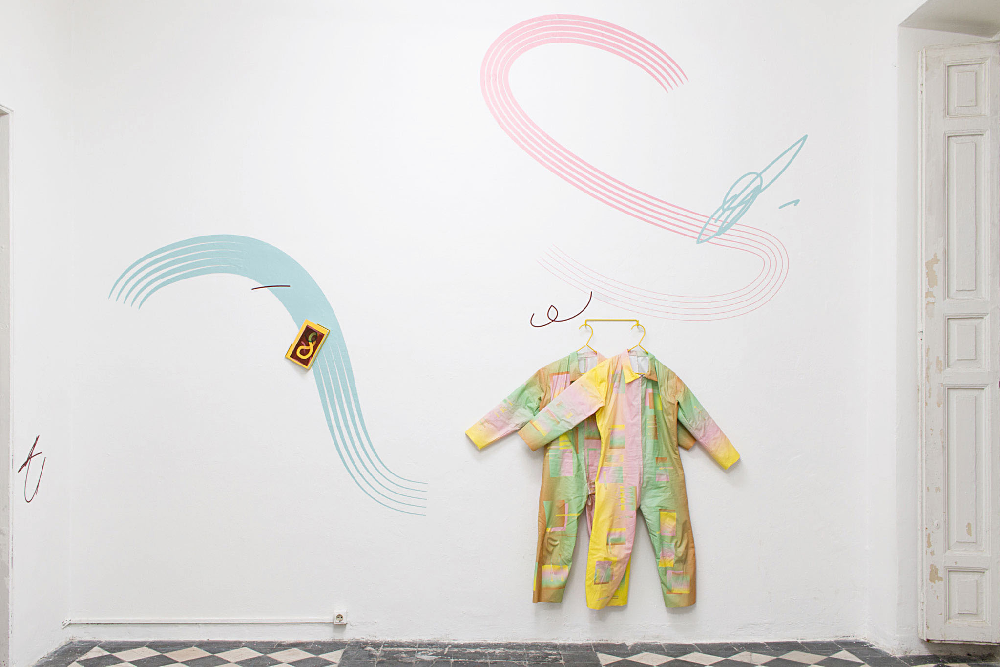Mădălina Zaharia
When I Occupy the Present
How does one reconcile the pressure of presenting oneself in a self-assertive and professional manner with imaginative and creative actions? When I occupy the present was driven by Mădălina Zaharia’s interest in the nature of the “artist talk” and its widespread presence in the contemporary art world. The artist took the PowerPoint as a case study, at first a business or sales-pitch tool that has now become a prominent device giving a narrative and visual form to public presentations in diverse contexts.
Zaharia’s production process started in the early months of 2019 with two workshops held in Timișoara. Working together with a group of young graduates and peer artists from the city, she used isolated and stylized graphic elements from PowerPoint presentations such as Basic Shapes, Block Arrows and Callouts in order to collectively examine the performative make-up of an artist talk. Reinterpreted versions of these embellishments have later appeared as graphic components in the film, and on the costumes worn by the two performers, referencing what data visualization researcher Edward Tufte, calls PowerPoint Phluff. The term refers to any array of visual decorations that try to distract from the lack of content in a presentation, or attempt to make it more appealing to an otherwise disengaged audience.
In the film shot by the artist at the Youth House together with a local team, the graphic elements with tones of green and teal are camouflaged in the location that becomes the background of a performative presentation. The movements adopted by the two performers throughout the film are based on a controversial theory of power posing developed by the psychologist Amy Cuddy. Presented during what is, to date, the second most viewed TED Talk online, the theory states that our body language and posture are crucial in achieving our goals by emulating the exact same power and space we are striving to attain. The series of postures and attitudes that are meant to choreograph and perform the very idea of success are complemented by the film’s voiceover. Mixing corporate and software language, the script emphasizes how technology serves the marketization of the self. AR
Mădălina Zaharia (b. 1985, Sighetu Marmaţiei) is a Romanian artist who lives and works in London. She graduated from the Royal College of Art, London, with an MA in Printmaking in 2012. Zaharia’s practice combines design and personal narratives in order to disrupt and scrutinise reality, employing digital printing, 3D objects, performance, film and sound as a way of questioning and enhancing ordinary experience. Recent projects include: Reading as Rhythm: A Sonic Exploration of the Visual Vocabulary of Control Magazine, Tate Exchange, Liverpool (2018); DEBT., Tintype Gallery, London, (2017, solo); Tender Buttons, SALÓN, Madrid (2017); Say What?, ASC Gallery, London (2016); Identify Your Limitations, Acknowledge The Periphery, Vitrine Gallery, London, (2016); The Staging of an Exhibition, Ivan Gallery, Bucharest, (2016, solo); London Open 2015, Whitechapel Gallery, London; and Feel the discourse!, Guest Projects, London (2015).

Mădălina Zaharia, Tender Buttons, 2017, SALÓN, Madrid, courtesy of the artist, photo credit: Christian Lübbert
Dan Acostioaiei
Halil Altındere
Forensic Architecture
Anca Benera & Arnold Estefan
Michael Beutler
Pauline Boudry & Renate Lorenz
Irina Botea Bucan & Jon Dean
Filipa César & Louis Henderson
Kray Chen
Collection Collective
Céline Condorelli
Alexandra Croitoru
Decolonizing Architecture Art Residency
Chto Delat
Aslan Gaisumov
Dora García
Ane Graff
Alma Heikkilä
Ane Hjort Guttu
Gülsün Karamustafa
Behzad Khosravi Noori
Gunilla Klingberg
Vilmos Koter
Zac Langdon-Pole
Matts Leiderstam
Anne Low
Virginia Lupu
Taus Makhacheva
Liliana Mercioiu Popa
Metahaven
Ana Maria Millán
Malgorzata Mirga-Tas
Naeem Mohaiemen
Monotremu
Tanja Muravskaja
Ciprian Mureșan
Joar Nango
Thao Nguyen Phan
Ho Tzu Nyen
Pınar Öğrenci
Ahmet Ögüt
The Otolith Group
Trevor Paglen
Philippe Parreno
Gary-Ross Pastrana
Peles Empire
Lia Perjovschi
Agnieszka Polska
Ghenadie Popescu
Walid Raad
Vandy Rattana
Bella Rune
STEALTH.unlimited
Zhou Tao
Iulia Toma
Tur de Arhitectură
Mona Vătămanu & Florin Tudor
Anton Vidokle
Haegue Yang
Mădălina Zaharia
Zephyr
Želimir Žilnik
